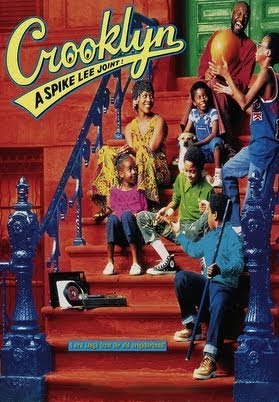
Crooklyn Dir. Spike Lee
Feat. Zelda Harris (Troy), Alfre Woodard (Carolyn), Delroy Lindo (Woody), Spike Lee (Snuffy)
Universal Pictures, 1994
Crooklyn, a 1994 semi-autobiographical film co-written and directed by Spike Lee. The film takes place in the Bedford-Stuyvesant neighborhood of Brooklyn, New York during the summer of 1973. The time period was right before the crack epidemic had begun, in the early 80's and late 90's. The introduction of the film begins with an upbeat rhythm and vibrant color palette in contrast to the film, Winter's Bone which began with a country rhythm and dull color palette. The film is remarkable through its aspect of choice. The title choice, sing choices throughout the film, and more importantly the choice for the film.
Spike Lee is well thought out. He wanted to focus on the truth of Brooklyn, New York, opposing the stereotypes that it's given. That the reason for the film title, Crooklyn. The film title was not of his choice, it was the title stamped by the majority through their negative views upon the town. Through their lens, Brooklyn is seen through violence, drugs, death, and minimal opportunity for success. However, Spike Lee challenges the viewpoints with the reality. Kids were still doing kid activities like jumping rope, bantering, listening when their parents called them in for dinner, racing bikes, and hassling adults. Then comes the dinner scene where a black family as a whole is having dinner together both parents and all children enjoying the precious moment of joy. This fights the stereotype of the father never being there. Yes, viewers might be awaiting the point where it turns into "Crooklyn", but it never happens. The only hardships experienced are bills being unpaid, tight budgets, disagreements and disputes, and death. However, they are overcome together, as a family. A powerful frame of the introduction is the scene of an afro. He made sure to place this in the film to represent originality and origin.
Spike Lee does a great job using various techniques to portray a deeper message. As the family takes a family trip to the south, they arrive at aunt Song's home. As soon as they enter the home, the movies become difficult to view as if it was stretched out too much. This was the use of an anamorphic/fisheye lens. It was to help portray confusion to the audience, the family is unfamiliar with the environment so the lens is helping the audience to understand the sense of awkwardness. The music choice was very well done as it created additional emotion and tone to make a stronger connection to the film. During the end of the film, as the funeral was going on, "Things will get brighter" is playing non-diegetically. I felt the reason for this is to tell the audience that death is a very tragic moment indeed, however as a family it can be overcome and everyone will be able to see the brighter picture.
I would personally recommend this film to the majority who lack the bigger picture upon culture. The reason for so much culture conflict is due to the lack of understanding that we are all similar in the problems we face and the trials and tribulations we go through. The only difference is the options we are granted whether they be for better or worse.
curry 6
ReplyDeleteyeezy
canada goose
bape hoodie
off white shoes
yeezy shoes
curry 7
jordan sneakers
golden goose outlet
kobe 9